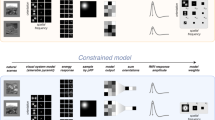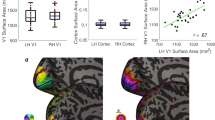Abstract
Visual perception critically depends on orientation-specific signals that arise early in visual processing. Humans show greater behavioral sensitivity to gratings with horizontal or vertical (0°/90°; ‘cardinal’) orientations than to other, ‘oblique’ orientations. Here we used functional magnetic resonance imaging (fMRI) to measure an asymmetry in the responses of human primary visual cortex (V1) to oriented stimuli. We found that neural responses in V1 were larger for cardinal stimuli than for oblique (45°/135°) stimuli. Thus the fMRI pattern in V1 closely resembled subjects' behavioral judgments; responses in V1 were greater for those orientations that yielded better perceptual performance.
This is a preview of subscription content, access via your institution
Access options
Subscribe to this journal
Receive 12 print issues and online access
$209.00 per year
only $17.42 per issue
Buy this article
- Purchase on Springer Link
- Instant access to full article PDF
Prices may be subject to local taxes which are calculated during checkout

Similar content being viewed by others
References
Campbell, F. W., Kulikowski, J. J. & Levinson, J. J. Physiol. (Lond.) 187, 427–436 (1966).
Orban, G. A., Vandenbussche, E. & Vogels, R. Vision Res. 24, 121–128 (1984).
Heeley, D. W. & Timney, B. Vision Res. 28, 337–344 (1988).
Mansfield, R. J. Science 186, 1133–1135 (1974).
De Valois, R. L., Yund, E. W. & Hepler, N. Vision Res. 22, 531–544 (1982).
Maffei, L. & Campbell, F. W. Science 167, 386–387 (1970).
Finlay, B. L., Schiller, P. H. & Volman, S. F. J. Neurophysiol. 39, 1352–1361 (1976).
Matin, E. & Thoms, J. Percept. Psychophys. 35, 589–591 (1984).
Buchanan-Smith, H. M. & Heeley, D. W. Perception 22, 1389–1402 (1993).
Orban, G. A., Dupont, P., Vogels, R., Bormans, G. & Mortelmans, L. Eur. J. Neurosci. 9, 246–259 (1997).
Coppola, D. M., White, L. E., Fitzpatrick, D. & Purves, D. Proc. Natl. Acad. Sci. USA 95, 2621–2623 (1998).
Levitt, J. B., Kiper, D. C. & Movshon, J. A. J. Neurophysiol. 71, 2517–2542 (1994).
Engel, S. A. et al. [erratum published in Nature 370, 106 (1994)] Nature 369, 525 (1994).
Sereno, M. I. et al. Science 268, 889–893 (1995).
DeYoe, E. A. et al. Proc. Natl. Acad. Sci. USA 93, 2382–2386 (1996).
Acknowledgements
We are grateful to Mark Cohen for his assistance with fMRI. We also thank John Mazziotta, the UCLA Brain Mapping Medical Organization, the Ahmanson Foundation, the Pierson-Lovelace Foundation, the Tamkin Foundation and the Jennifer Jones-Simon Foundation for their support.
Author information
Authors and Affiliations
Corresponding author
Rights and permissions
About this article
Cite this article
Furmanski, C., Engel, S. An oblique effect in human primary visual cortex. Nat Neurosci 3, 535–536 (2000). https://doi.org/10.1038/75702
Received:
Accepted:
Issue Date:
DOI: https://doi.org/10.1038/75702
This article is cited by
-
Neural tuning instantiates prior expectations in the human visual system
Nature Communications (2023)
-
Feature-based interaction between masks and target in continuous flash suppression
Scientific Reports (2023)
-
Type of residual astigmatism and uncorrected visual acuity in pseudophakic eyes
Scientific Reports (2022)
-
Conceptual knowledge shapes visual working memory for complex visual information
Scientific Reports (2022)
-
Natural scene sampling reveals reliable coarse-scale orientation tuning in human V1
Nature Communications (2022)



